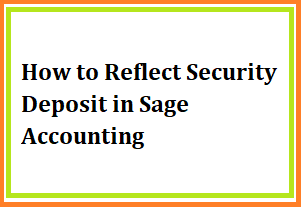How to Reflect Security Deposit in Sage Accounting

How to Reflect Security Deposit in Sage Accounting ,Security deposits are one of the most important elements of a business. They act as a safeguard against any damages caused to property or equipment during a tenant’s lease. As such, it’s vital that security deposits are handled correctly in order to ensure compliance with applicable laws and regulations. This is where Sage Accounting comes into play. Sage Accounting is a powerful accounting software that helps businesses manage their finances more effectively. In this article, we will discuss how to reflect security deposits in your Sage Accounting books so that you can keep track of them more efficiently.
Find-: Setting up Accounts Payable in Sage 50
What is a security deposit?
A security deposit is a amount of money, usually equal to one month’s rent, that a tenant pays to a landlord at the beginning of a lease. The deposit is held in escrow by the landlord during the tenancy and is returned to the tenant at the end of the lease, minus any damages that may have occurred during the lease period.
In Sage Accounting, security deposits are reflected as liabilities. This means that they are recorded as an amount owed by the tenant to the landlord. When the security deposit is returned to the tenant at the end of the lease, the liability is removed from the Sage Accounting system.
How to create a security deposit in Sage Accounting
To create a security deposit in Sage Accounting, follow these steps:
- From the main menu, choose Customers > Enter Customer Deposits.
- In the Customer Deposits window, select the customer for whom you want to enter a deposit.
- Enter the amount of the deposit in the Amount field.
- In the Description field, enter a description of the deposit (for example, “Security Deposit”).
- Choose the account into which you want to deposit the money from the drop-down list in the Account field. This is typically a bank account.
- Click Save & Close to save the deposit and close the window.
Find more-: Sage 50 Error 1923
How to record a security deposit refund
Assuming you are using the accrual method of accounting, when you receive the security deposit back from your tenant, you would record it as a refund of an expense. In your accounting software, create an account called “Security Deposits” and classify it as an Other Expense type account. When you collect the security deposit from your tenant, you would record it as a negative number in this account. Then, when you receive the deposit back from your tenant, you would record it as a positive number in this account. The net effect would be zero because the money was just temporarily held in this account.
How to reflect a security deposit in Sage Accounting
When you receive a security deposit from a tenant, you need to record it in your Sage Accounting software. To do this, follow these steps:
- Go to the Accounts Receivable menu and select Enter Transactions.
- In the Customer field, enter the name of the tenant who paid the security deposit.
- In the Type field, select Security Deposit.
- In the Date field, enter the date on which you received the security deposit.
- In the Amount field, enter the amount of the security deposit.
- In the Reference field, enter a description of the security deposit (e.g., “Security Deposit for Apartment 123”).
- Click Save & Close.
Security deposit best practices
When it comes to security deposits, there are a few best practices you should follow in order to ensure accurate accounting in Sage. First, always create a separate ledger account for security deposits in your chart of accounts. This will make it easier to track and report on these funds.
Next, when you receive a security deposit from a tenant, be sure to immediately record it as a Receipt in Sage. Include all relevant details such as the amount received, the date, and the Ledger account you created for tracking security deposits.
Finally, when a tenant moves out and their security deposit is returned, be sure to record this as a Payment in Sage. Again, include all relevant details such as the amount received, the date, and the Ledger account you created for tracking security deposits.
Following these simple best practices will help ensure accurate accounting for security deposits in Sage.
Conclusion
Reflecting a security deposit in Sage accounting is a simple and straightforward process. By following the steps outlined in this article, you can ensure that your company’s financial records are up to date and accurate. It is essential to properly record security deposits on Sage accounting so that your business can remain compliant with all governmental regulations. With careful attention to detail and just a few clicks of the mouse, you can easily make sure that your business’s financial information remains accurate at all times.





